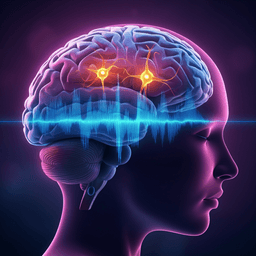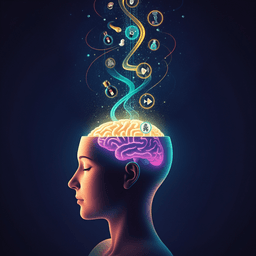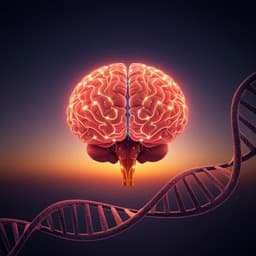
Medicine and Health
Augmenting hippocampal-prefrontal neuronal synchrony during sleep enhances memory consolidation in humans
M. Geva-sagiv, E. A. Mankin, et al.
This groundbreaking research by Maya Geva-Sagiv and colleagues reveals how hippocampal-prefrontal neuronal synchrony during sleep plays a vital role in enhancing memory consolidation. By utilizing precise closed-loop deep brain stimulation, the team discovered that time-locking stimulation to MTL slow waves significantly boosts neural activity and recognition memory accuracy. Discover how brainwave synchronization can transform our understanding of sleep’s impact on memory!
~3 min • Beginner • English
Introduction
The systems-level consolidation theory posits that newly formed declarative memories initially depend on the hippocampus and are gradually reorganized to the neocortex. During non-rapid eye movement (NREM) sleep, hippocampal sharp-wave ripples (~80–120 Hz in humans) interact with cortical slow waves (<4 Hz) and thalamocortical sleep spindles (9–16 Hz), providing a temporal framework for memory reactivation and transfer. Although extensive correlative evidence links these oscillations with memory, causal evidence in humans is scarce. The present study tested whether precisely synchronizing prefrontal stimulation to endogenous MTL slow-wave active phases during sleep would enhance hippocampo-thalamocortical coupling and, consequently, overnight consolidation of declarative memory.
Literature Review
Prior research shows sleep benefits long-term memory consolidation and implicates coordinated hippocampal–neocortical interactions. Rodent studies causally link hippocampal ripples to consolidation and demonstrate coupling between ripples, cortical slow waves, and thalamic spindles. Human invasive and noninvasive recordings reveal hippocampal–neocortical interactions during sleep, but direct causal links to memory remain limited. Closed-loop acoustic stimulation can enhance slow oscillations and spindles with mixed effects on memory; a key unresolved issue has been the impact on hippocampal ripples. Theoretical and empirical work suggests that slow-wave active phases provide a privileged window for effective interventions. This study leverages intracranial recordings and closed-loop stimulation to target these phases directly in humans.
Methodology
Participants: Eighteen adults with pharmacoresistant epilepsy undergoing intracranial depth electrode monitoring at UCLA (ages 19–47) participated. All provided informed consent. Intracranial iEEG and microwire recordings sampled MTL and neocortical sites. Twelve participants completed full behavioral testing; six additional participants contributed neurophysiology only.
Design: Within-participant crossover with two nights (order counterbalanced): (1) intervention night with real-time closed-loop (RTCL) stimulation during early NREM sleep, and (2) undisturbed sleep night. The RTCL intervention comprised alternating 5-min stimulation (STIM) and 5-min pause blocks over ~45–90 min (~90 min total targeted), initiated after at least 30 min of consolidated NREM sleep.
Closed-loop stimulation: One MTL iEEG contact (gray matter) served as a synchronization probe; a neocortical contact (typically orbitofrontal white matter; 15/19 sessions) served as the stimulation site. Online detection of MTL slow waves (0.5–4 Hz) triggered brief, high-frequency stimulation bursts (50 ms trains at 100 Hz; 5 pulses, 0.5–1.5 mA; current-regulated, charge-balanced), spaced ≥3–4 s apart. Two stimulation modes were used: (i) synchronized (sync) stimulation time-locked to the MTL slow-wave active phase (iEEG trough, triggered with adaptive delay after the preceding positive peak; mean post hoc delay ~241 ms), and (ii) mixed-phase stimulation with identical parameters but not phase-locked. Safety monitoring ensured stimulation below after-discharge thresholds; epileptogenic areas were avoided.
Sleep staging and signals: NREM epochs were identified from iEEG by a data-driven classifier (Gaussian mixture of slow-wave and spindle power). Polysomnography was not always available; post hoc scoring confirmed 76%±5.1% of stimulations occurred during NREM. iEEG was recorded at 2 kHz; microwire spiking at 28–30 kHz. Pathological events (interictal epileptiform discharges) were detected and censored; noisy channels and high-IED channels were excluded.
Memory task: A visual paired-associate learning (vPAL) task presented 25 person–animal pairs during evening learning. Immediate post-learning tests assessed (a) recognition (25 learned faces mixed with 15 lures; accuracy = hit rate − false alarm rate) and, contingent on old responses, (b) association (recall of the paired animal). The same tests were repeated in the morning after sleep. Reaction times were recorded. A separate psychomotor vigilance task (PVT) assessed vigilance changes.
Analyses: Electrophysiology included stimulation-locked time–frequency analysis (spectrograms) and event detections for slow waves, spindles (9–16 Hz; fast spindles >11 Hz subset), and MTL ripples (80–100 Hz; bipolar referencing; automated criteria). Immediate effects were quantified in short windows after stim vs sham (pause) time points matched for slow-wave phase; prolonged effects were assessed by comparing 1-min post-STIM vs end-of-pause intervals using normalized indices. Spike-phase locking of single units to MTL slow-wave phase was quantified by cosine fits to spike-phase distributions to assess locking depth and preferred phase. Cross-structure coupling was evaluated as double (MTL ripple with neocortical slow wave) and triple (ripple + slow wave + spindle) co-occurrence incidences in MTL–prefrontal electrode pairs. Statistics included Wilcoxon signed-rank and rank-sum tests and Spearman correlations.
Key Findings
- Behavioral: Sync-stimulation in prefrontal white matter improved overnight recognition memory accuracy relative to undisturbed sleep in all individuals tested at that site (6/6; binomial P=0.01). Mixed-phase stimulation showed a trend toward degraded recognition performance; sync-stimulation at posterior neocortical sites yielded mixed results. Association (pairing) accuracy showed no reliable effect. Reaction times for recognition were unchanged; PVT improvements were smaller after intervention vs undisturbed sleep, indicating the memory effect was not due to generalized performance gains.
- Spindles and slow waves: Sync-stimulation immediately increased spindle (sigma, 9–16 Hz) power beyond sham moments matched to slow-wave phase (565 contacts; P<1e−30 to ~1.4×10−14 depending on analysis). In time-domain detections, spindle probability increased in the 3 s after sync-stim (P<1e−10), but decreased after mixed-phase stimulation (P<1e−10). Slow-wave event probability decreased immediately after both stimulation modes. Prolonged effects: sync-stimulation produced widespread increases in spindle event rates across both hemispheres and regions (including MTL and neocortex), while mixed-phase stimulation reduced spindle rates; between-mode comparisons were highly significant (P<1e−10). Slow-wave rates were comparable pre/post for sync-stim but decreased after mixed-phase stimulation (between-mode P<1e−10).
- Correlations with behavior: Across participants, the degree of immediate spindle enhancement correlated with recognition memory accuracy improvement (Spearman ρ≈0.69, P=0.013; n=12). A similar positive trend within sync-stim participants alone did not reach significance.
- Neuronal spiking: During STIM blocks, the fraction of units outside MTL significantly phase-locked to MTL slow-wave active states increased from 34% (PRE) to 50% (STIM). Prolonged increases in locking depth were observed immediately after STIM blocks, especially outside MTL (e.g., Wilcoxon signed-rank P=0.007 for units outside MTL; aggregated immediate post-STIM across units P<1e−9), decaying within minutes.
- Ripples and cross-structure coupling: Ripple detection probability in MTL transiently decreased immediately after stimulation (both modes) but showed no prolonged change in rate. Critically, sync-stimulation increased prolonged double co-occurrence of MTL ripples with neocortical slow waves (right-tailed Wilcoxon signed-rank P<1e−3; n=25 pairs) and increased triple co-occurrence with fast spindles (P=0.03; n=5 pairs), whereas mixed-phase did not. The increase in double co-occurrence correlated with improvement in recognition accuracy (Spearman ρ≈0.8, P=0.007; n=30 pairs across 8 participants).
Discussion
The study provides causal evidence in humans that enhancing the temporal coupling among hippocampal ripples, cortical slow waves, and thalamocortical spindles during sleep supports memory consolidation. Real-time synchronization of prefrontal stimulation to MTL slow-wave active phases increased spindle activity, strengthened brain-wide spike phase-locking to MTL slow waves, and enhanced ripple–slow wave–spindle coupling. These electrophysiological changes tightly tracked improvements in recognition memory accuracy, underscoring the mechanistic role of coordinated hippocampo-thalamocortical oscillations in systems consolidation. Timing was critical: identical stimulation without precise phase-locking failed to produce, and sometimes impaired, electrophysiological coupling and behavior. Effects were widespread, consistent with white-matter stimulation efficacy and known MTL–prefrontal interactions. Behaviorally, improvements mainly reflected reduced false alarms (source memory benefits), aligning with prior reports that sleep reduces false memories. Together, findings support models in which NREM sleep’s coordinated oscillations provide temporal windows for hippocampal–neocortical communication essential for stabilizing memories.
Conclusion
By leveraging intracranial recordings and closed-loop stimulation synchronized to MTL slow-wave active phases, this work demonstrates a causal link between hippocampo-thalamocortical synchronization during sleep and improved human memory consolidation. The approach robustly enhanced spindles, spike phase-locking, and ripple–slow wave–spindle coupling, and improved recognition accuracy when precisely timed. These results inform systems consolidation theory and suggest translational potential for closed-loop DBS to bolster memory in clinical populations. Future research should optimize stimulation timing parameters, assess generalizability to non-epileptic populations and diverse cortical targets, and determine whether direct modulation of hippocampal ripples further augments memory benefits.
Limitations
- Participants were patients with pharmacoresistant epilepsy on antiepileptic medications, which can alter sleep architecture and oscillations; generalizability to healthy populations remains to be established. Within-participant design and heterogeneous clinical profiles mitigate, but do not eliminate, confounds.
- Mixed results for non-prefrontal stimulation sites and small behavioral sample sizes limit conclusions about optimal targets and effect sizes.
- Stimulation did not increase ripple incidence; memory benefits were associated with coupling, not ripple counts, leaving open whether direct ripple modulation is necessary or beneficial.
- The precise stimulation timing used may not be optimal; further refinement could enhance efficacy.
- Potential residual influences of interictal epileptiform discharges cannot be fully excluded, though changes in IED rates did not correlate with memory benefits.
Related Publications
Explore these studies to deepen your understanding of the subject.







